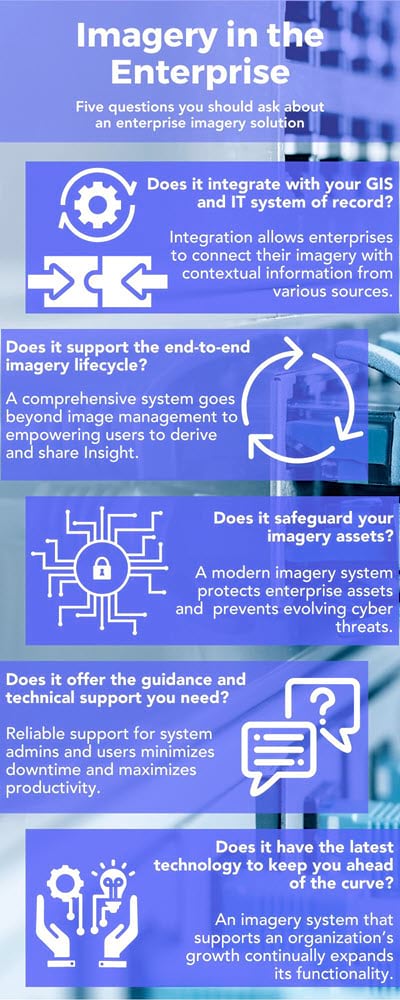In today’s data dependent world, it’s hard to conceptualize that imagery was not always a readily available data source. In fact, it was only thirty short years ago that imagery came on to the commercial business scene with Lockheed Martin being granted one of the first licenses for commercial satellite high-resolution imagery. Even then, imagery was virtually out of reach for most organizations. Smaller operations that were forward thinking enough to use imagery to support their business likely had one or two computers that were powerful enough to access and download images over the course of days or even weeks. The value of imagery was not fully realized, and if it was, there wasn’t access to enterprise-level IT systems to support it and make it available across the organization.

These days, all the buzz in the business and public sector (government) is about accessing, storing, and exploiting big data, and imagery is, well, as big as it gets. Smart organizations across industries and disciplines are capturing it, storing it, and making it available across functions in their enterprises to make decisions, improve operational efficiency, and ultimately provide a competitive edge. Companies are looking for ways to drive local and even global initiatives, and using imagery. Imagery represents a huge opportunity to help them achieve these goals.
Compared with the past when imagery was primarily used as a stand-alone, independent data point, most organizations want to incorporate imagery with their other business data so that all information in concert allows them to make more informed decisions. A foundational change is combining imagery and remote sensing data with Geographic Information Systems (GIS) workflows. This integration provides the geographic context they need to get valuable insights into their business.
Not all data is created equal
With any opportunity comes challenges. Imagery is not like other big data. It’s massive data, and it’s unstructured so it needs to be managed differently in order for it to be operational in planning or decision making. Unstructured data is not simply rows in a database. It is captured, stored, and analyzed differently than structured data. It requires a lot of space and specialized AI tools to analyze it.
Accessing, managing, and disseminating imagery across the enterprise can be a daunting task for organizations without infrastructure specifically designed for imagery. Piecing together parts of a system, most of which are designed for traditional data types, creates an environment that is not optimized for organizational teams to fully exploit the value of imagery. Enterprises require a purpose-built system.
Five questions you should ask yourself before you implement an enterprise imagery solution
We’ve developed an informative infographic and supporting blog content to offer valuable insights into the crucial aspects to consider when planning for an imagery system within your enterprise. These resources aim to provide a concise yet comprehensive guide to help you navigate the complexities of implementation and maximize the benefits of available technology.

1. Does it integrate with your GIS and IT system of record?
A complex imagery and remote sensing data puzzle is emerging within modern enterprises. Data comes from disparate sources, and imagery can come not only from satellites but from drones, crewed aircraft, mobile mapping systems, and security cameras. Along with other remotely sensed data, such as SAR and Lidar, this wealth of information can now be used to accelerate decision-making processes. However, all of it needs to be available to the people who need it, when they need it, how they need it, in order for it to be a smart business investment.
As the need for image handling accelerates, many enterprises are turning to open source to put together an imagery system. One notable disadvantage of relying solely on open-source enterprise image management solutions is their fragmented nature – managing pieces and parts rather than offering a complete imaging system integration within existing workflows.
ArcGIS is unique as it contains a comprehensive imagery system that is seamlessly integrated within its comprehensive GIS. This integration enables enterprises to connect their imagery with contextual information from various sources. By treating imagery as part of a larger whole, organizations unlock deeper insights into their operations while maximizing the value derived from imagery and remote sensing data.
2. Does it support the end-to-end imagery lifecycle?
Having an end-to-end imagery system that supports the entire imagery lifecycle is essential for organizations for several key reasons. An end-to-end imagery system eliminates the need to integrate multiple disjointed tools or platforms. It enables organizations to efficiently manage and track imagery from acquisition to analysis and ensures smooth workflows.
ArcGIS offers comprehensive support for the entire imagery and remote sensing data lifecycle, enabling organizations to seamlessly navigate through each stage. The capabilities of ArcGIS flow effortlessly, starting from the initial acquisition of imagery, either through our valued imagery partners or using ArcGIS Living Atlas of the World. With access to vast stores of high-quality content, users can easily discover and obtain relevant imagery and remote sensing datasets that align with their specific needs.
Once acquired, ArcGIS provides powerful tools for managing the data as part of an organization’s system of record. This includes robust data storage, organization, and cataloging functionalities that ensure efficient management and easy accessibility for users across the enterprise.
ArcGIS goes beyond just managing imagery; it empowers users to derive meaningful insights from most types of imagery and remote sensing data:
- Through advanced analysis techniques such as image classification or change detection algorithms powered by geospatial artificial intelligence (GeoAI), users can extract valuable information from their imagery to gain deeper understanding and make informed decisions.
- ArcGIS offers exceptional visualization capabilities that enable users to create compelling visual representations based on their analyzed imagery data. Whether in the form of interactive maps or dynamic dashboards, these visualizations allow stakeholders to grasp complex information easily and facilitate effective communication across teams or with external partners.
- ArcGIS facilitates sharing and dissemination of information derived from imagery through various channels. Users can publish their findings as web services which allows them to share through secure portals within their organization or with the public. This capability ensures that valuable insights derived from imagery are accessible by those who need them most.
ArcGIS supports every aspect of the imagery lifecycle – from discovery and acquisition to management, analysis, visualization sharing, and dissemination – providing organizations with a comprehensive solution that enables them to harness the full potential of their imagery and other geospatial data.
3. Does it safeguard your imagery assets?
When it comes to handling sensitive data like imagery within an enterprise environment, security is paramount. Organizations need a system of record that takes its safety into consideration. Open-source solutions may offer certain security measures; however, they often lack comprehensive protection for data, especially when considering the sheer size of imagery data stores. An enterprise imagery system must be underpinned by security and safety measures that protect intellectual property and thwart evolving cyber threats.
ArcGIS is built explicitly for enterprise users and incorporates robust security features designed to protect your valuable assets throughout their lifecycle. With advanced authentication protocols and encryption mechanisms in place, ArcGIS ensures your organization’s sensitive imagery remains secure from unauthorized access or data breaches. Put yourself at ease knowing you can call us, when you need help the most.
4. Does it offer the guidance and technical support you need?
Having robust technical support for an enterprise imagery system is crucial for organizations. Implementing and managing an imagery system can be complex, and having access to knowledgeable experts who can provide guidance and assistance is invaluable. Technical support ensures that any issues or challenges encountered while working with the imagery system are addressed promptly, minimizing downtime and maximizing productivity. It also enables organizations to make the most of the features and capabilities of their imagery system by offering insights, tips, and best practices. Additionally, technical support helps organizations stay up to date with the latest advancements in image management technology through regular updates and training resources. Reliable support ensures that organizations can fully leverage their enterprise imagery system to drive innovation, enhance decision-making processes, and achieve their business goals.
ArcGIS goes beyond competition in providing comprehensive support for all aspects of its imagery system. With a dedicated support team comprised of account managers to technical support, users can rely on prompt assistance and guidance whenever they encounter challenges or have questions regarding the implementation, management, or utilization of imagery within ArcGIS. Additionally, ArcGIS offers a vibrant user community and user group where professionals from different industries come together to share their experiences, best practices, and innovative solutions related to imagery integration. This collaborative environment allows users to lean on each other for help, exchange ideas, and tap into a wealth of knowledge that further enhances their understanding and proficiency in leveraging ArcGIS for their imagery needs.
5. Does it include the latest technology to keep you ahead of the curve?
Staying ahead of the curve in today’s rapidly evolving digital landscape is crucial for organizations to remain competitive and maximize their productivity. By piecing together your own system, you may risk missing out on essential updates and advancements necessary for optimizing enterprise workflows. With each technological advancement comes new features and functionalities that can greatly expand the capabilities of an imagery system. These may include automated feature extraction tools, machine learning algorithms for object recognition or classification tasks, reality mapping integration, real-time monitoring options, and many others.
ArcGIS offers a wide range of capabilities that enable organizations to stay and get ahead of the competition. With regular feature updates driven by user feedback and emerging industry trends, ArcGIS continually expands its functionality to meet business and government’s evolving needs. This means that enterprises using ArcGIS have access to the latest tools available in the market for efficiently and effectively working with and exploiting imagery and remote sensing data.
One advanced capability provided by ArcGIS is reality mapping, which allows users to integrate highly accurate, 3D representations of real-world objects into their digital maps. This technology bridges the gap between the physical and digital worlds, enhancing spatial understanding. Reality mapping supports various applications such as terrain modeling, urban planning simulations, or asset management.
Furthermore, ArcGIS empowers users with advanced analysis and observation capabilities. Through techniques like spatial pattern detection, organizations can uncover hidden insights within their imagery data that might not be evident through traditional methods alone. ArcGIS also integrates geospatial artificial intelligence (GeoAI) capabilities into its platform. This allows enterprises to leverage deep learning for tasks such as feature extraction, object recognition, and image classification – automating processes and increasing efficiency in managing large volumes of imagery and remote sensing data.
ArcGIS is built for enterprise imagery
Imagery now plays a pivotal role in enterprises across diverse domains including agriculture monitoring systems or urban planning applications where accurate representation holds immense significance.
Choosing ArcGIS as the enterprise imagery solution of record empowers organizations to treat imagery – and all geospatial data – strategically rather than simply isolating images themselves. By providing enhanced security measures alongside regular feature updates tailored for enterprise users’ needs while offering seamless GIS integration capabilities – it becomes clear why embracing a complete enterprise system like ArcGIS represents a significant business advantage. Investing now in an all-encompassing image and geospatial data management solution solidifies not only efficient process workflows but also positions imagery and remote sensing assets as strategic components within overall business strategies, ultimately positioning organizations for sustainable success.


Great article thank you. I am curious about ‘Calculated Attribute Values’ in SmartForms. Does this mean values entered for an attribute can be calculated within that field entry? For instance, can I enter 4×5 + 6×7 into a field labeled “Area” and have it return 62 as the value for that attribute?
I am building a FieldMap for collecting area quantities of newly constructed street/sidewalk improvements and it would make a lot of sense for field measured values to be entered directly rather computing and then entering.
Thanks
Liam
9/19/2023 – Are there any new articles and tutorials that guide our capabilities for the features mentioned in “What’s coming next?”